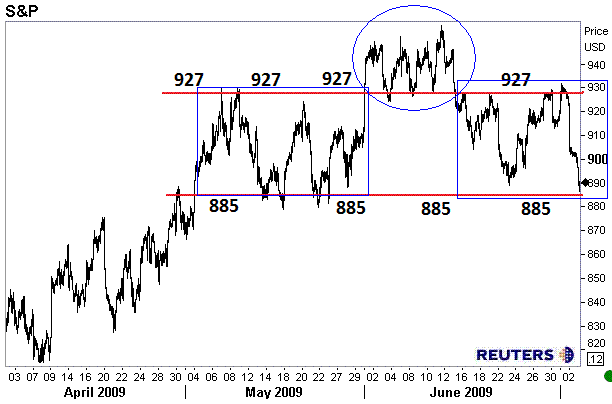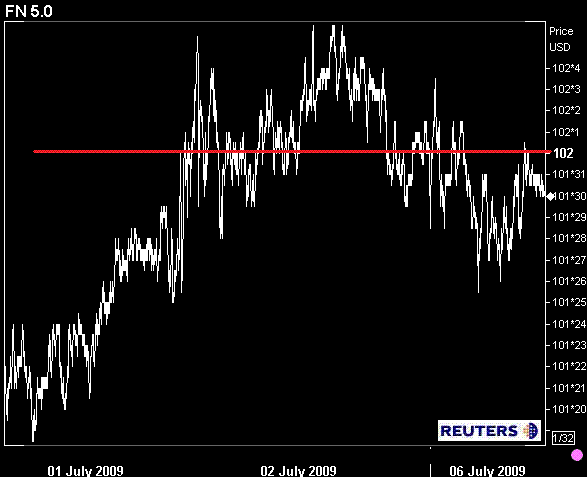Anyone notice how much time I have been spending talking about market technicals lately? I have been posting charts with a good amount of noise/overlays...most of which outline a range and define pivot points. This is for good reason! The market place is very uncertain about the road to recovery. Economic indicators are mixed, some show signs of stabilization, while others, such as housing and the outlook for consumer spending, remain weak under the pressure of a feeble labor market.
This morning "talking heads" are spending much time debating the extent to which the marketplace a "baked" a recovery into stock prices. Guests are being asked questions like: "do we see the S&P test March lows? and "Has momentum in equities been nothing more than a bear market rally?". The market's fundamentals are indeed under scrutiny as stocks have hit a firm ceiling. The street is no longer investigating the idea of green shoots, it is seeking more signs of stabilization.
The massive amount of market mysteries have had perplexing effects on equity indices and benchmark Treasury yields. Interest rate volatility remains high as supply of debt mounts, while stock traders are seemingly stuck...searching for some sort of direction. This indecision has translated into a RANGE BOUND marketplace. Well...the release of the Employment Situation report last Thursday pushed the S&P down to a price point that may provide a better idea of a "range to come".
The firm resistance I discussed above is 888/885 price range on S&P. Notice the head and shoulders formation (Matt will explain head and shoulders later)...
 D
D
Plain and Simple: this price point is key. A sustained move below 885 would push the S&P to levels not seen since April. Psychologically this would lead to further investigation of the perception of "green shoots". The likelihood of a rapid recovery would be further discounted. Much optimism would be lost as the market turned defensive. The market would be looking to test support instead of chasing resistance. Bears would take over control.
However...the multiple mysteries moderating the marketplace are not likely to be ignored by bargain buyers. The idea of unknown outcomes has an upside too as many wont want to miss the boat on the perception of a "bargain basement" price. This leads us to believe the range trade will remain. Selloffs will likely slow as market participants "buy on dips" while rallies will likely be limited by profit takers. Perhaps we see the S&Ps 885/927 range hold all summer? That too is a mystery but we are definitely at a cross roads, a turning point, the markets are looking to give themselves some guidance.
Why does all this matter to mortgages?
In order for mortgage rates to move lower, benchmark big brothers need to find a stable range. WE NEED INTEREST RATE VOLATILITY TO CALM. Interest rate volatility will keep MBS buyers nervous, skittish, edgy, wary, anxious, tense, jumpy, and panicked at times too.
Why?
This you have read before but I am using it again!
When benchmark interest rates (TSYs) rise both the duration and expected life of "out of the money" (at par or below par) MBS coupons increase (longer life). The farther out of the money an MBS coupon is, the more it's duration and life will extend (can only extend so much though) when benchmark rates rise because those borrowers backing the loans that make up the MBS have no reason to refinance if their interest rate is lower than current market.
Plain and Simple: MBS buyers dont want to be stuck in a fixed income investment that isn't keeping up with its benchmark (benchmark yields higher than MBS coupon yield)...if interest rates move higher this implies those MBS holders could be reinvesting their money in a higher yielding debt instrument...they could be earning more return/MORE CASH FLOWS!!!!
Now lets apply the academic background knowledge to the currently volatile choppy interest rate environment. Remember Black Wednesday? Remember the crowd fleeing a burning building? Traders do not want to put themselves in that position again. This is a function of the BIG PICTURE OUTLOOK which remains a BIG MYSTERY. The BIG MYSTERY has brought about a higher amount of volatility into the interest rate marketplace. More volatility implies the outlook for forward looking interest rates is wide....anything can happen! If benchmark rates go, the life of "rate sheet influential" MBS coupons grows longer and longer. The extending life of those MBS coupons is a scary thing to investors because it means they could stuck holding an MBS coupon that is underperforming the yields of current market risk free benchmarks (bc only the borrower can exercise the embedded call option in MBS)...which brings us full circle. Hence why we have seen panic-like selling of "rate sheet influential" MBS coupons every time Treasury yields start to rise. Hence why MBS investors are hesitant to jump on the TSY rally bandwagon...hence wider MBS/TSY yield spreads!
LESS VOLATILITY is step one to a sustainable rally in MBS world. WE NEED A CLEARER ECONOMIC OUTLOOK. Of course weakness in stocks helps, but as we have already described, unless a spotlight is placed on economic ineffciencies...equity indices will likely remain range bound.
After that...in order for us to see 4.50% on rate sheets again....somehow, someway, the trading side of the mortgage market (secondary market) needs to get nervous about prepayment risk. That means the MBS trading world needs to feel like a "IT THAT SHALL NOT BE NAMED" (havent said that in a while!) is looming. Do you think we see lending guidelines relaxed enough to increase traders fear of prepayment risk? Doubtful...(this is the "What came first? The Chicken or the Egg?" debate.)
Since prepay risk it not something we seeing as becoming a big MBS concern, demand for current coupon MBS should remain low. This implies the "up in coupon" bias should continue to impair the extent to which "rate sheet influential" MBS rally and the Federal Reserve will be left alone to fight off originator supply and servicer hedging strategies (servicers provide demand side support too btw).
This sentiment has indeed been the case so far this morning. MBS trading flows are slow, volume is light, "rate sheet influential" yield spreads are wider, and "up in coupon" is getting more attention. Its been a slow morning and lenders are aware of it as most rate sheets are worse. Thank the unknown economic outlook for that...stocks are testing lows, but holding at key support. Meanwhile, bonds are "waiting around" for stocks to make up their mind. In this environment lenders will be hesitant to go out on limb with aggressive pricing because of the higher probability that rates will move lower in the near future (weakness in stocks).
Remember: if rates move lower, borrowers who are already locked in will request a lower mortgage rate. This is "fall out risk". Fall out risk is bad for a pipeline manager...to avoid this risk, lenders will be passive pricers, unwilling to go too far one way or another...RANGE BOUND. Instead of seeing added YSP...you might be getting other forms of incentives...such as fee waivers as loans go CTC. Lenders will be willing to pay for DELIVERY RELIABILITY....anyone getting aggressive mandatory commitment pricing?
Plain and Simple: the entire marketplace is still searching for guidance. TSYs are awaiting a better indication from stocks. MBS are awaiting calmer leadership from Treasuries.
Here is two day chart of FN 5.0. 102-00 level continues to moderate gains...

10 yr TSY note range: 3.46 to 3.55
2s vs. 10s: 258bps
The Treasury Department will auction $8bn 10 YR TIPS notes at 1pm. We will update if this auction brings about price volatility.





